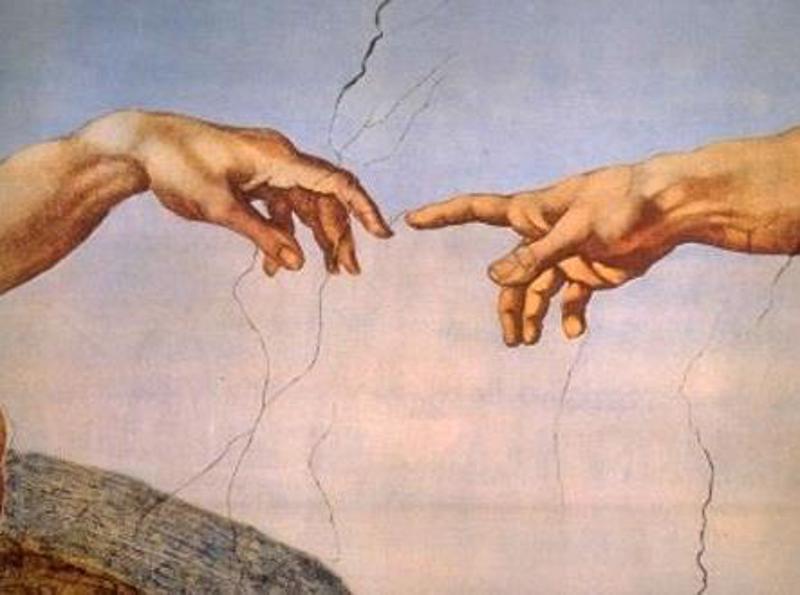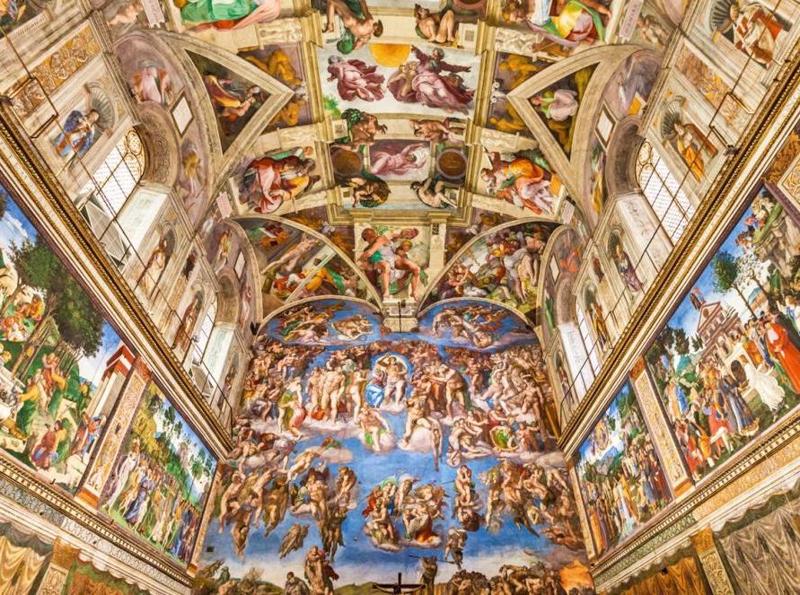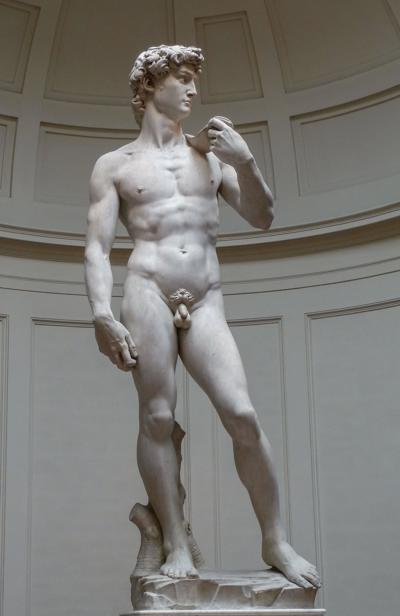A trip into the Italian Renaissance
The Sistine Chapel, located in Vatican City, Rome, is the fourth stop we will be visiting. It was built by Michelangelo, another great contributor to the Renaissance. Michelangelo was a poet, painter, sculptor, and architect. The chapel is right next to St. Peter's Basilica, who Michelangelo also worked on. The ceiling of the Chapel is probably the most intricate and eye-catching aspect about it, and just like Da Vinci painted his own depiction of Jesus and his twelve disciples, Michelangelo made the ceiling his depiction of Genesis and the nine scenes from it. Michelangelo took 4 years to paint the ceiling of the Chapel, and according to one of his students Ascanio Condivi, who observed him through all of it wrote in a biography the struggles that his teacher went through painting the Sistine Chapel. "While he was painting, Pope Julius often wanted to go and inspect the work; he would climb up by a ladder and Michelangelo would hold out a hand to him to help him up onto the scaffolding. And, being one who was by nature impetuous and impatient of waiting, as soon as the work was half done, that is from the door to midway on the vault, he wanted Michelangelo to uncover it while it was still incomplete and had not received the last touches." Condivi stated that a unique struggle that Michelangelo faced after painting the ceiling was being able to read looking down. After looking up and painting the ceiling for almost 4 years, he interestingly got accustomed to looking at things upwards, making it difficult for him to read texts when he looked down, although he was able to fix this issue after awhile. Michelangelo felt of himself as more of a sculptor than a painter, despite his beautiful work in the chapel. He sculpted one of the many famous renaissance statues, "David" who Michelangelo sculpted in the time that Florence was facing political conflicts. The marble statue is of a fully naked man, his face looks to the left and he holds a sling over his shoulder. According to Saul Levine in the book "Michelangelo's Marble "David" and the Lost Bronze "David": The Drawings." Levine interprets the positioning of David as a way to examine Florence's conflicts. "Michelangelo's marble David incorporates two formal symbolic approaches related to its right and left sides. The right side is passive and quiescent, emphasizing a deter-
mined capacity which stresses political and diplomatic solu-
tions for the crisis confronting the Florentines in 1501. The
left side, the traditional active side of threat and danger, uti-
lizes the iconographic pictorial type of a Fighting David to
emphasize military resistance against a political Goliath if nec-
essary" (Levine 101) In one of Michelangelo's sketches of David, which were one of his rough drafts of what the statue would look like, he wrote a small excerpt that said "David with his sling, and I with my bow" which can be essentially up for interpretation for the reader, but the underlying meaning behind it is the bow is Michelangelo's wits and intellect, while the sling is David's physical power and force.
nicolelopez9396
7 chapters
28 Oct 2020
Fourth Stop: The Sistine Chapel
December 31, 1507
|
Vatican City, Rome, Italy
The Sistine Chapel, located in Vatican City, Rome, is the fourth stop we will be visiting. It was built by Michelangelo, another great contributor to the Renaissance. Michelangelo was a poet, painter, sculptor, and architect. The chapel is right next to St. Peter's Basilica, who Michelangelo also worked on. The ceiling of the Chapel is probably the most intricate and eye-catching aspect about it, and just like Da Vinci painted his own depiction of Jesus and his twelve disciples, Michelangelo made the ceiling his depiction of Genesis and the nine scenes from it. Michelangelo took 4 years to paint the ceiling of the Chapel, and according to one of his students Ascanio Condivi, who observed him through all of it wrote in a biography the struggles that his teacher went through painting the Sistine Chapel. "While he was painting, Pope Julius often wanted to go and inspect the work; he would climb up by a ladder and Michelangelo would hold out a hand to him to help him up onto the scaffolding. And, being one who was by nature impetuous and impatient of waiting, as soon as the work was half done, that is from the door to midway on the vault, he wanted Michelangelo to uncover it while it was still incomplete and had not received the last touches." Condivi stated that a unique struggle that Michelangelo faced after painting the ceiling was being able to read looking down. After looking up and painting the ceiling for almost 4 years, he interestingly got accustomed to looking at things upwards, making it difficult for him to read texts when he looked down, although he was able to fix this issue after awhile. Michelangelo felt of himself as more of a sculptor than a painter, despite his beautiful work in the chapel. He sculpted one of the many famous renaissance statues, "David" who Michelangelo sculpted in the time that Florence was facing political conflicts. The marble statue is of a fully naked man, his face looks to the left and he holds a sling over his shoulder. According to Saul Levine in the book "Michelangelo's Marble "David" and the Lost Bronze "David": The Drawings." Levine interprets the positioning of David as a way to examine Florence's conflicts. "Michelangelo's marble David incorporates two formal symbolic approaches related to its right and left sides. The right side is passive and quiescent, emphasizing a deter-
mined capacity which stresses political and diplomatic solu-
tions for the crisis confronting the Florentines in 1501. The
left side, the traditional active side of threat and danger, uti-
lizes the iconographic pictorial type of a Fighting David to
emphasize military resistance against a political Goliath if nec-
essary" (Levine 101) In one of Michelangelo's sketches of David, which were one of his rough drafts of what the statue would look like, he wrote a small excerpt that said "David with his sling, and I with my bow" which can be essentially up for interpretation for the reader, but the underlying meaning behind it is the bow is Michelangelo's wits and intellect, while the sling is David's physical power and force.



Share your travel adventures like this!
Create your own travel blog in one step
Share with friends and family to follow your journey
Easy set up, no technical knowledge needed and unlimited storage!